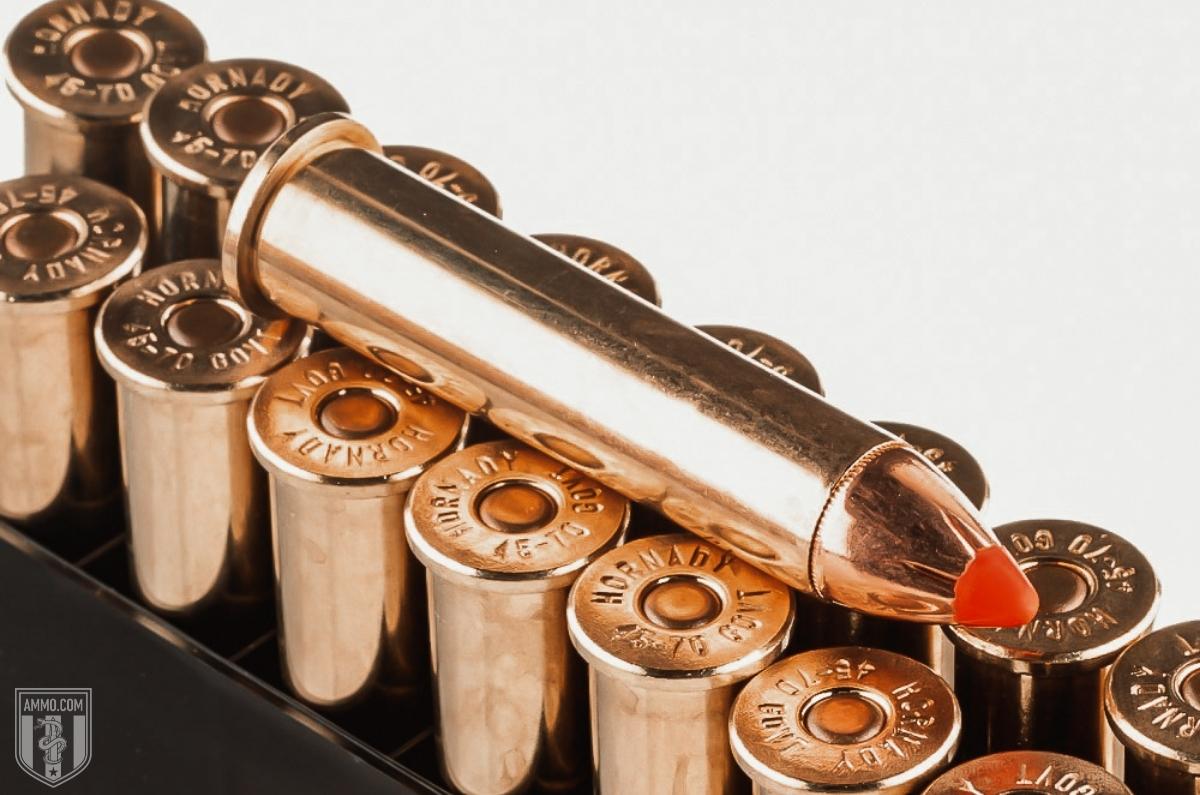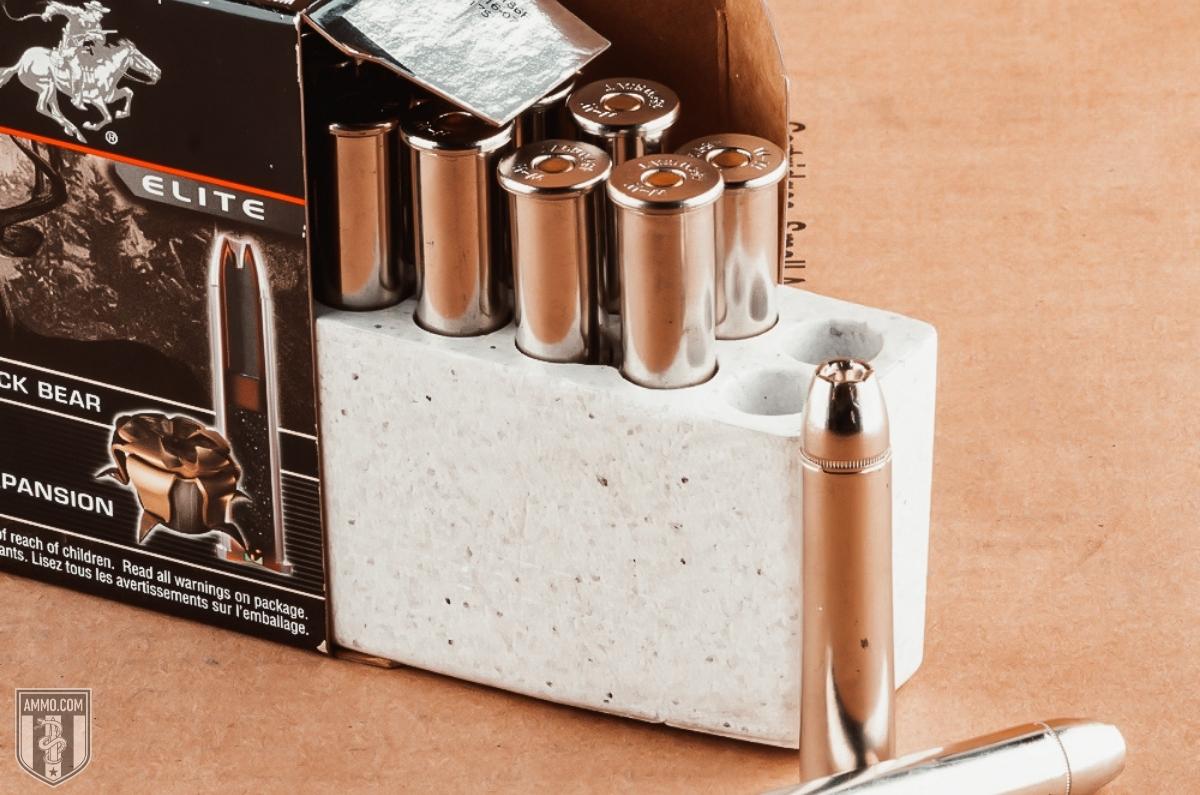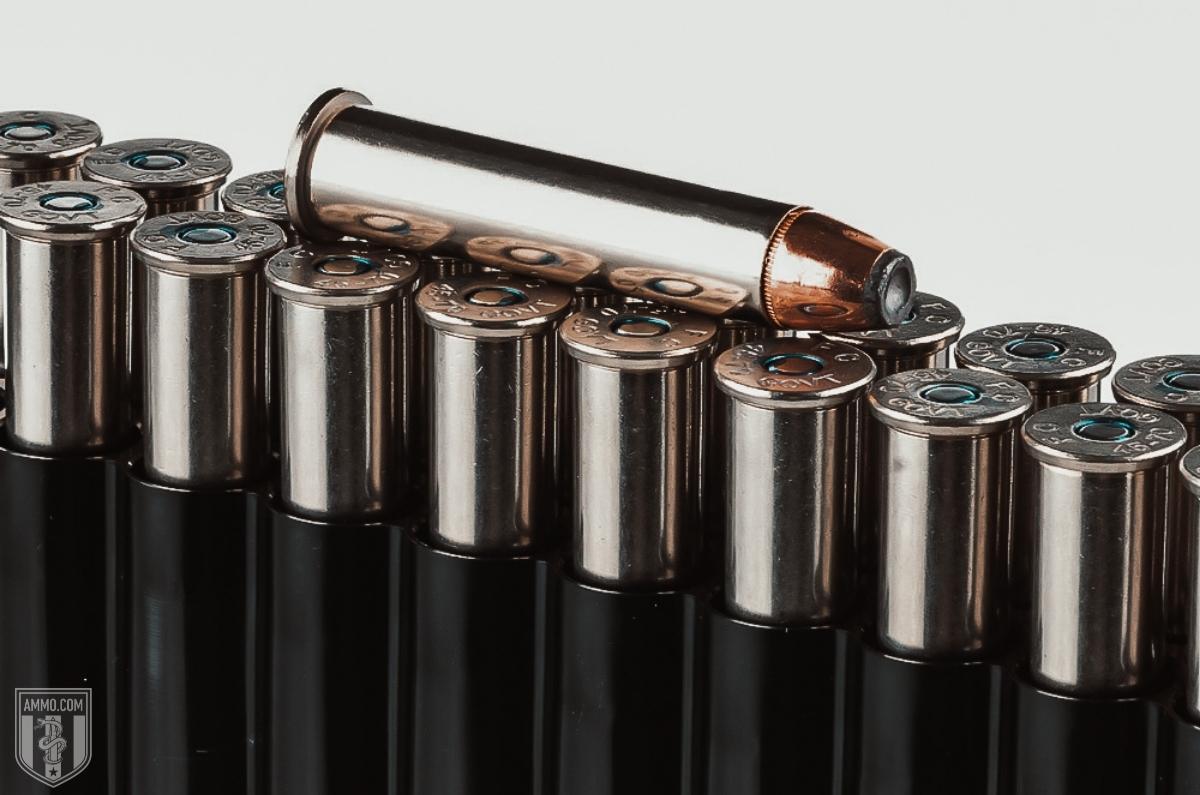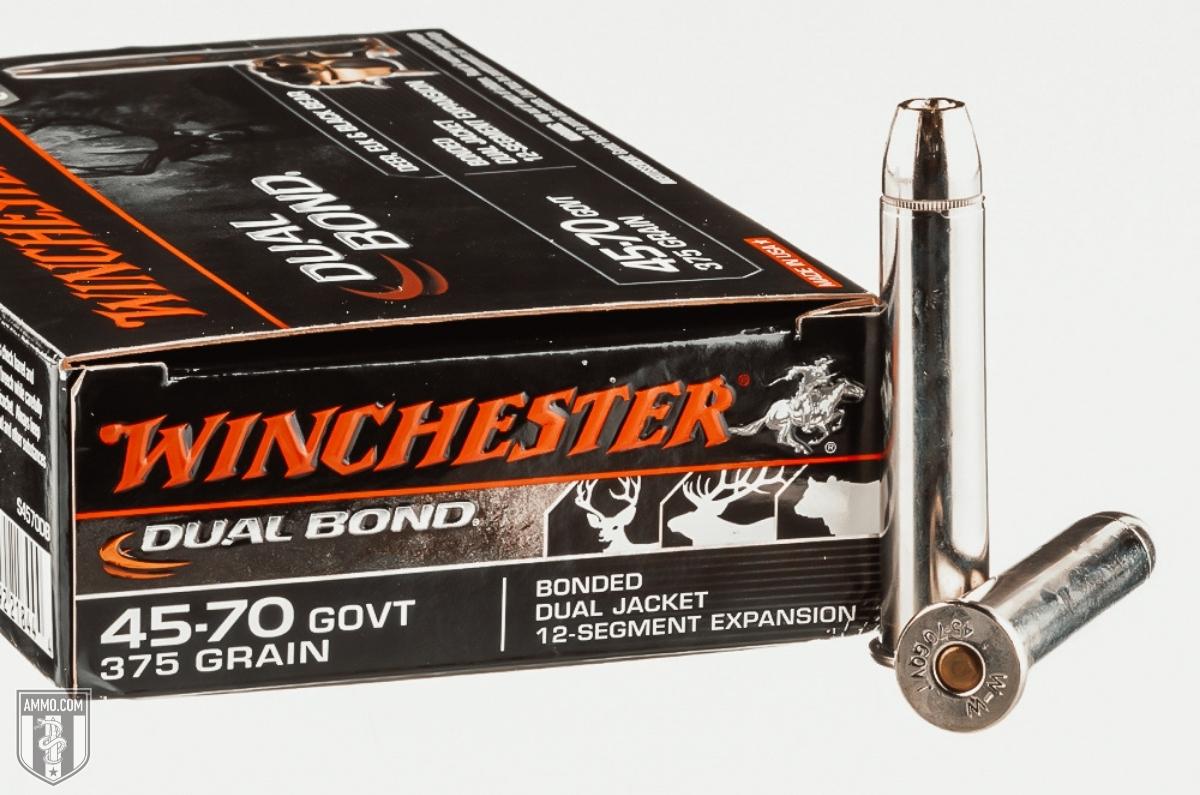45 90 vs 45 70: The Black Powder Rifle Cartridges That Won the West

The wide-spread adoption of the metallic cartridge shortly after the close of the American Civil War signaled a massive step forward in firearms technology. Many iconic cartridges emerged during the period between 1865 and 1890, cartridges like the 45 Colt, the 38-40 WCF, and the 44-40 Win, just to name a few.
However, two of the most iconic lever action rifle cartridges developed during this time were the 45-90 Winchester Center Fire (WCF) and 45-70 Government.
The 45-70 has endured the test of time and is still in use today as a hunting round while the 45-90 has fallen into relative obscurity and is typically only seen in antique firearms or at Cowboy Action Shooting competitions.
In this article we will examine the similarities and differences between these two big bore lever gun cartridges that arguably won the West.
Cartridge Specs
When evaluating centerfire rifle cartridges, it’s a good idea to analyze the cartridge specs to gain more knowledge of each.
Both the 45-90 Winchester and 45-70 Government (or "Govt" for short) were originally designed as black powder cartridges for long range shooting and big game hunting.
Perhaps the most obvious difference between these two big bore cartridges is their case length. The 45 90 and 45 70 are big cases by modern standards, however they needed to be large to house all the black powder necessary to propel the cast lead bullets at acceptable velocities.
The 45 90 and 45 70 are identical in all dimensions except their case length. The 45-70 has a case length of 2.105” while the 45-90 measures 2.40”. This means that it is possible to fire 45-70 cartridges in a rifle chambered for 45-90. However, this practice is not advised, as the large jump required for the 45-70 bullet will often cause increased throat erosion and leading in your 45-90 barrel.
In terms of bullets, both cartridges fire the same 0.458” bullet diameter.
Original cast bullets for the 45 90 were referred to as paper patched as they were wrapped with a thin layer of paper. This was done to reduce lead deposits (called “leading”) in the barrel as bullets in this time period were considerably softer than modern hard cast bullets.
The paper patch also helped the bullet make a full seal in the barrel, increasing muzzle velocity, consistency, and accuracy as the bullet fully engaged the rifling. The paper would quickly peel off the bullet after it exited the barrel thanks to air resistance. The development of lead hardening and bullet lube made the paper patch bullet obsolete, but these advancements came later.
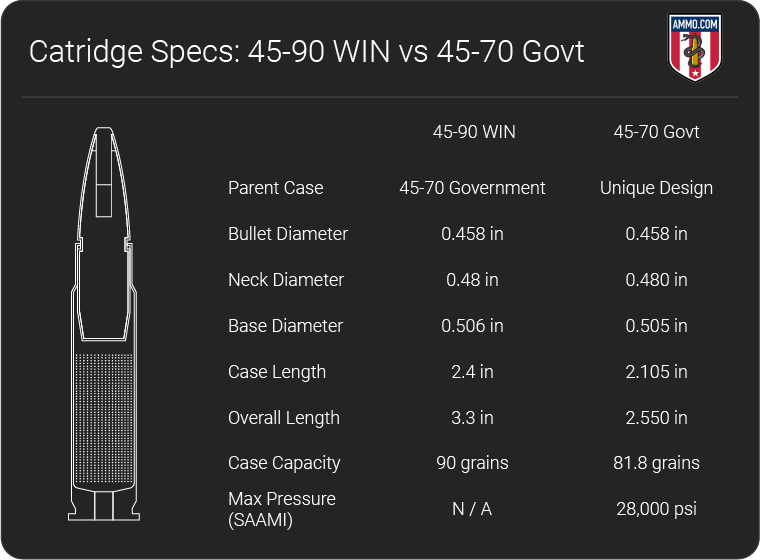
Cartridge Naming and Load Variations
One thing that can be confusing to new shooters is the older naming system, which is different than modern ammunition.
The original names for both cartridges are 45-90-300 and 45-70-405. Here’s what that means using the 45 90 as an example:
- 45: The cartridge fires a 0.458” diameter bullet
- 90: The powder charge is 90 grains of black powder
- 300: The bullet weight is 300 grains
If you do some digging on internet forums, you might come across the name 45-90 Sharps Straight and wonder if it is a different cartridge. There is some confusion surrounding the naming of the 45-90 cartridge, as many a gun forum moderator might be unaware that the 45-90 Sharps Straight does not exist.
The actual designation of the Shiloh Sharps cartridge is the 45 2 4/10 Sharps Straight, which is also written as “45-2.4” for short. The 45-90 Winchester and 45 2 4/10 Sharps Straight are identical cartridges in terms of external dimensions, the difference lies in the load that each cartridge was developed for.
The 45-90 WCF was typically loaded with a 300-grain bullet seated to an overall length of 2.6” to reliably cycle in the Winchester 1896 lever gun. On the other hand, the 45-2.4 Sharps Straight was initially loaded with a 500-grain paper patch bullet that was later increased to 550 grains
The Advent of Smokeless Powder
In 1884, the French chemist Paul Vieille is credited with the creation of the first smokeless gunpowder. Shortly thereafter in 1886, the French released the first metallic cartridge to use smokeless powder, the 8x51R Lebel.
The advent of smokeless powder signaled a change in firearm design, as the new powder had a faster burn rate and, in turn, created higher chamber pressures. This can cause an extremely dangerous if not potentially life-threatening problem if smokeless powder is used in a firearm made for black powder.
The 45-70 Govt and, to a lesser extent, the 45 90 are two classic examples of black powder cartridges that have made the transition into using smokeless powder.
The original firearm designed to fire the new 45-70 cartridge was the Springfield Model 1873, or as it is more commonly called, the Springfield Trapdoor. The M1873 was a breech-loading single shot design that was developed for black powder loads.
Although the Springfield Trapdoor and only served in the US military from 1873 to 1892, a large quantity of rifles were produced and have become a bit of a collectors item among firearms enthusiasts. However, the problem begins with the introduction of smokeless powder, as the older 45-70 Govt rifles are not rated for the higher pressures that smokeless powder cartridges create.
The 45-70 is a big case that can hold a lot of powder. All this case capacity was needed to handle the large black powder loads the round needed to achieve the desired results down range. However, with smokeless powder, considerably less powder is needed to achieve similar ballistic performance.
This means that the ballistic performance of the 45-70 is primarily limited to the strength of the firearm chamber shooting the cartridge. Seeing an opportunity to improve on the cartridge, new lever action rifles like the Winchester 1886 and Marlin 1895 were chambered in 45-70 and were capable of handling higher pressure loads.

Modern adaptations of the 45-70 can achieve similar ballistic performance close to the 458 Win Mag but require even stronger chambers to handle the added pressure. Modern metallurgy and firearm design has allowed the 45-70 to reach what many online shooting forum members refer to as “nuclear loads” for the 45-70.
These modern loads are not appropriate for use in a Springfield Trapdoor or older lever action rifles as the chamber pressures these cartridges are capable of would damage or destroy the rifle and potentially harm the shooter.
This has led to the creation of three classes of smokeless ammunition for the 45-70 per the 49th Edition of the Lyman Reloading Handbook:
- 1873 Trapdoor Springfield loads
- 1886 Winchester and 1895 Marling only
- Ruger No. 1 and No. 3 only
Most custom ammo manufacturers will specify what their 45-70 loads are appropriate for. For example, Buffalo Bore has loads suitable for Trapdoor use, standard pressure rounds, and those only appropriate for single shot and bolt action rifles capable of magnum pressures.
It is a good practice to assume that any modern factory loads are NOT appropriate for use in older or antique firearms unless explicitly stated on the box or company website. When in doubt, the safest practice is to confirm with the ammo manufacturer and a qualified gunsmith before firing any new production smokeless powder factory loads through an older firearm to ensure they are safe to use.
Recoil
The 45 90 will generally have more recoil than the 45-70 Govt as the 45 90 has a larger case capacity to fire its bullets at higher velocity.
Felt recoil will differ from shooter to shooter and is dependent upon multiple factors like stance, shooting position, and firearm selection.
Free recoil is dependent on powder charge, muzzle velocity, bullet weight, and firearm weight.
For this example, we will use a Winchester 1886 lever action rifle weighing 8 pounds as a test firearm. The 45-70 round will be a 405-grain jacketed soft point traveling at 1,750 fps while the 45-90 bullet will be a 400-grain lead flat nose bullet 1,950 fps.
Given these specifications, the 45-70 will have around 33.50 ft-lbs of free recoil compared to 42.5 ft-lbs for the 45-90.
Muzzle Velocity, Kinetic Energy, and Trajectory
The 45-90 WCF will generally have higher muzzle velocity, kinetic energy, and a flatter trajectory than the 45-70 for similar bullet weights.
For this comparison we will consider the 405gr and 400gr loads for the 45-70 and 45-90, respectively, that were compared in the recoil section.
In terms of muzzle velocity, the 45 90 will generally shoot 200 fps faster than the 45-70. This is due to the 45-90’s larger case capacity and translates to higher muzzle energy and a better trajectory.
At the muzzle, the 45-90 is packing 3,377 ft-lbs of energy compared to 2,754 ft-lbs for the 45-70.
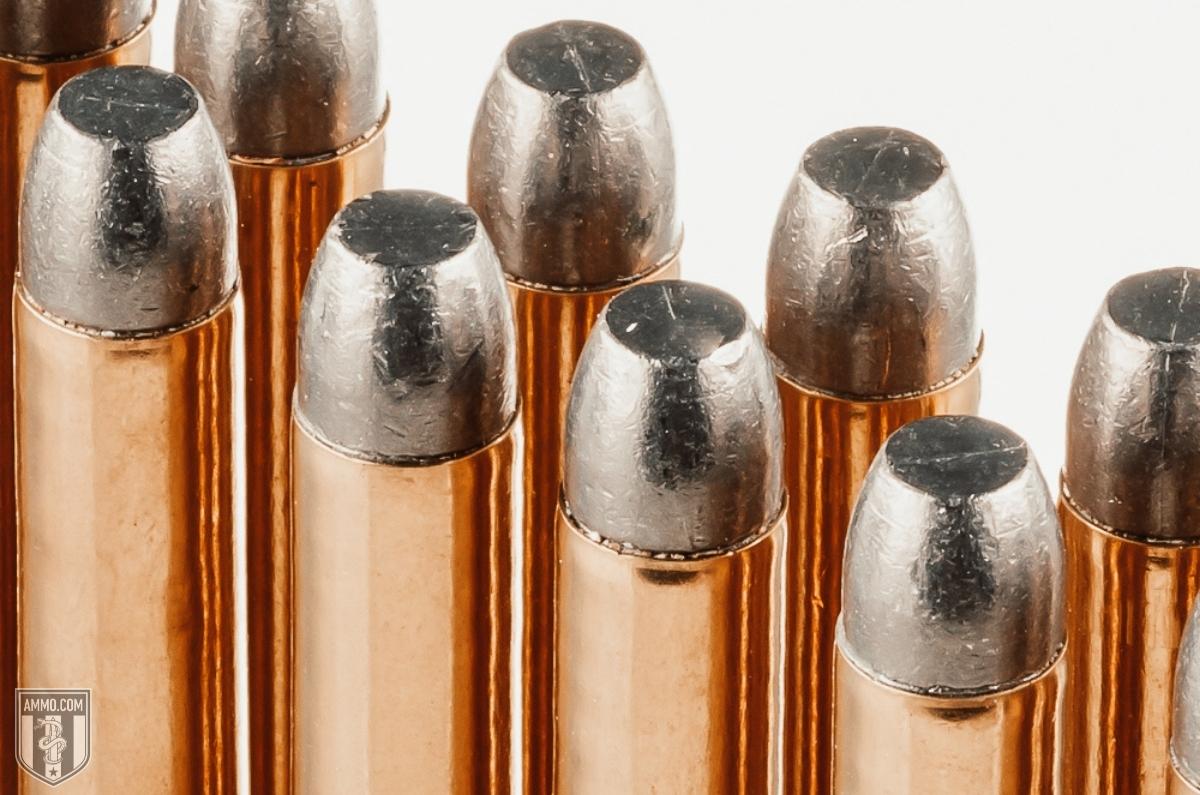
The increased muzzle energy allows the 45-90 to have a slightly longer effective range. The 45 90 can maintain 1,000 ft-lbs of energy, which is the recommended minimum for deer, to a little further than 400 yards. On the other hand, the 45-70 is dropping below 1,000 ft-lbs just beyond 300 yards.
For trajectory, the added muzzle velocity allows the 45 90 bullet to reach the target quicker than the 45 70 load. This means that gravity will have less time to affect the flight of the 45-90 bullet. At 300 yards, the 45-90 400 grain bullet has experienced around -38” of bullet drop compared to -50” for the 45-70.
All of the ballistic benefits for the 45-90 make it the better option for shooting heavier bullets at longer ranges with higher velocity.
Ballistic Coefficient and Sectional Density
Ballistic coefficient (BC) is a measure of how aerodynamic a bullet is and how well it will resist wind deflection. Sectional density (SD) is a way to evaluate the penetration ability of a bullet based on its external dimensions, design, and weight.
As both cartridges can fire the same bullets, there is no advantage for either in terms of BC.
In terms of sectional density, the slight muzzle velocity advantage the 45-90 has over the 45-70 means that the 45-90 will have slightly deeper penetration. However, it is unlikely that the deer will be able to tell the difference between either cartridge so long as your shot placement is on point.
Hunting
The 45-70 Government is one cartridge many shooters associate with a hunting guide gun. Especially with new magnum smokeless loads, the 45-70 provides more than enough kinetic energy and penetration to take on the most dangerous game North America and Africa have to offer.
Bears of all varieties and Cape Buffalo have all fallen before the mighty 45-70, which is a true testament to its stopping power and effectiveness against big game.
Deer and hogs stand no chance against the 45-70 within 300 yards, and many hunters enjoy the nostalgia of hunting with a classic Marlin 1895 or similar lever action rifle.
The 45-90 is an excellent choice if you expect to be taking longer range shots on deer sized game. However, ammo availability is a real problem for the 45-90 and most hunters who select this cartridge must resort to hand loading to maintain a reliable source of ammunition.
For this reason, the 45-70 Government is the de facto choice for most big game hunters who enjoy the classic feel of a lever gun.
Ammo and Rifle Cost/Availability
The 45-70 Government has numerous ammo and rifle options available while the 45-90 is more of a niche cartridge and harder to source ammo for.
The 45-70 has truly survived the test of time and has made the transition from black powder to smokeless powder thanks to its rugged design.
Ammo is relatively plentiful for the 45-70, especially for hunting and guide gun use. Offerings such as Federal Fusion, Remington Core-Lokt, and Hornady LEVERevolution are extremely popular with big game hunters and available for around $2-3/round. Custom loaded ammo for 45-70 is also available from Buffalo Bore, Underwood Ammo, and Black Hills.
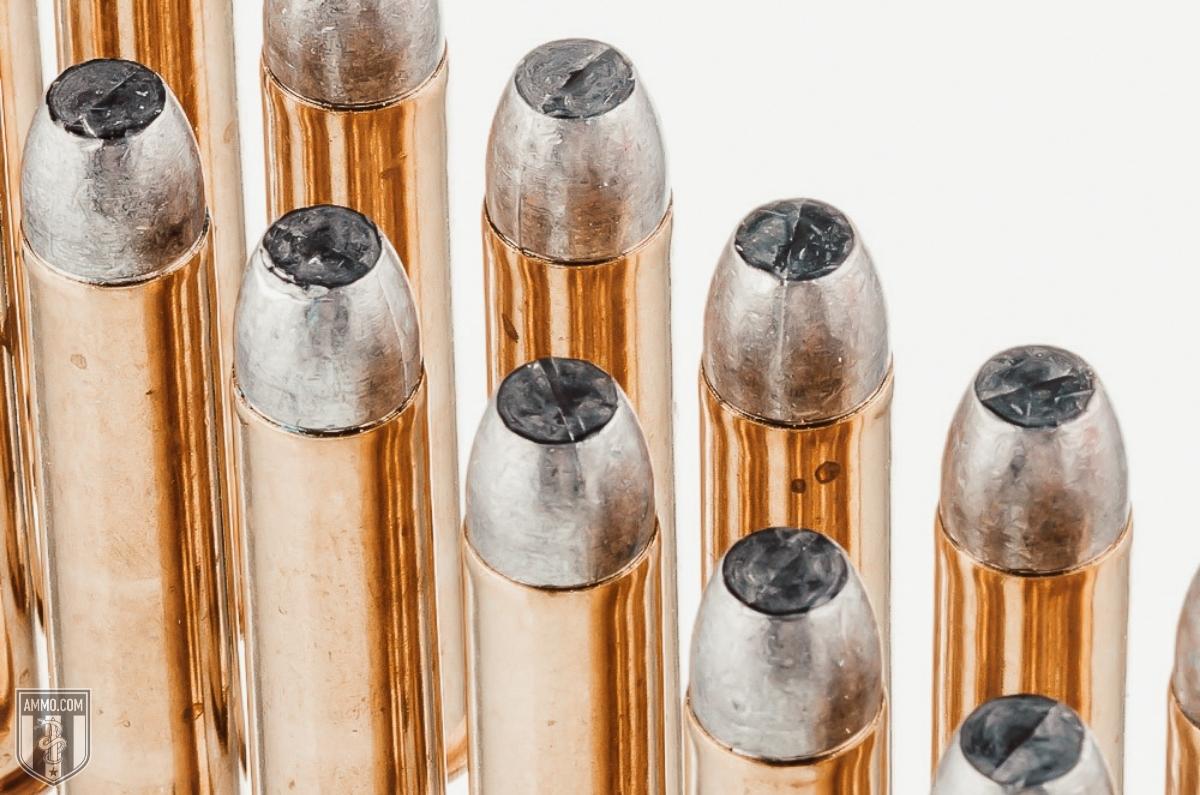
There are currently no companies that make factory loads for 45-90 as it is an obsolete cartridge. If you want to shoot 45-90, you need to get into reloading and hand load your own.
In terms of rifles, it is a relatively simple task to find a firearm for 45-70. The vast majority of options are either lever guns or single shot rifles from Winchester, Marlin, Henry, or Browning. However, for the adventurous firearms connoisseur, Magnum Research has a handgun chambered in 45-70, the BFR revolver.
For 45-90, finding a firearm is more difficult. The Winchester 1886 is the most common rifle chambered in the cartridge but if you have a lot of disposable income you could invest in a new production Shiloh Sharps breech loader for the true Wild West experience.
Reloading
If you plan on shooting 45-90, it is nothing short of a prerequisite that you hand load your own ammo.
Sourcing bullets and powder should not be difficult, as 0.458” diameter bullets are fairly common amongst Cowboy Action shooters. For brass, Starline is one of the few companies producing new brass for the cartridge.
Reloading for the 45-70, brass is less of an issue as multiple ammo manufactures produce new ammunition for the cartridge. This means that once-fired brass is considerably easier to purchase, although Starline still provides factory new brass if you prefer.
When reloading for either cartridge with smokeless powder, it is extremely important to start on the low end of the powder charge range and work your way up. Also, it is not advisable to fire smokeless loads in firearms built for black powder unless your loading data explicitly states that the loads are compatible with these antique rifles.
Final Shots: 45 90 vs 45 70
The 45-90 WCF and 45-70 Government are two iconic cartridges typically associated with lever action rifles and big game hunting.
The 45-70 Govt is still in service today and has successfully made the transition from black powder to a fully functional smokeless powder cartridge. It is beloved by hunters and has an air of nostalgia around it that harkens back to the Wild West. The 45-70 ballistics are impressive and this has allowed the cartridge to successfully harvest every big game animal North America has to offer, including the great bears.
The 45-90 Winchester Center Fire is a round that was originally developed for target shooting and hunting at longer ranges. The increased case capacity of the 45-90 allows it to surpass the 45-70 in virtually every ballistic category. Sadly, there are no ammo manufactures who currently produce factory loads for the 45-90 and there are only a handful of rifle options available for the cartridge.
Most shooters will opt for the 45-70, as factory ammo availability and modern rifle options make the 45-70 a great option for a guide gun. Although many 45-70 shooters do reload, it is not a requirement like it is for the 45-90.
The 45-70 is the better choice for most shooters, but this is not to suggest that you shouldn’t get a 45-90 if you really want one. Just understand that as an obsolete cartridge you’ll need to invest in a decent reloading setup and make sure you save your brass.
No matter which cartridge you choose, make sure you stock up on ammunition here at Ammo.com and I’ll see you on the range!
Ammo Comparisons
- .308 vs 5.56
- 6.5 Creedmoor vs .308
- .300 Blackout vs .308
- .300 Win Mag vs .308
- .243 vs .308
- .308 vs .30-06
- 7mm-08 vs .308
- .270 vs .308
- 7.62x39 vs .308
- .223 vs .308
- .338 Lapua vs .308
- .380 ACP vs 9mm
- .223 vs 5.56
- .300 Blackout vs 5.56
- 9mm vs 45 ACP
- 9mm vs 40 S&W
- .357 SIG vs 9mm
- 10mm vs 9mm
- 9mm vs 9mm Luger
- .243 vs .270
- .300 Win Mag vs .30-06
- .270 vs .30-06
- .40 vs .45
- 38 Special vs 357
- 9mm vs 40 vs 45
- 5.56 vs 7.62x39
- 338 Lapua vs .30-06
- .30-30 vs .30-06
- 300 PRC vs 338 Lapua
- .30-06 vs 7mm
- 300 Win Mag vs 338 Lapua
- 300 PRC vs 300 Win Mag
- 300 WSM vs 300 Win Mag
- 338 Win Mag vs 338 Lapua
- 12 Gauge vs 20 Gauge
- 10mm vs 357 Mag
- .30-30 vs 7.62x39
- 224 Valkyrie vs 22-250
- 17 HMR vs 22 Mag
- 7.62x39 vs .300 Blackout
- 45 ACP vs 45 Auto
- 45-70 vs 30-30
- 300 Blackout vs 223
- 357 Magnum vs 9mm
- 350 Legend vs 300 Blackout
- 224 Valkyrie vs 223
- 45 ACP vs 38 Super
- 6.5 Grendel vs .308
- 17 HMR vs 22 LR
- 10 Gauge vs 12 Gauge
- 22-250 vs 223
- 45 Colt vs 45 ACP
- 350 Legend vs 30-30
- 5.7x28 vs 223
- 5.7 vs 9mm
- 5.56 vs 5.7
- 22 vs 9mm
- Buckshot vs Birdshot
- 450 Bushmaster vs 308
- 450 Bushmaster vs 223
- Buckshot vs Slug
- 6.5 Grendel vs 5.56 vs 223
- 6mm ARC vs 6.5 Grendel
- 44 vs 45
- 458 SOCOM vs 5.56
- 357 vs 44
- 32 ACP vs 380
- 300 Win Mag vs 338 Win Mag vs 338 Lapua Mag
- 450 Bushmaster vs 458 SOCOM vs 50 Beowulf
- 6mm Creedmoor vs 6.5 Creedmoor
- TMJ vs FMJ
- 44 Special Vs 44 Magnum
- 45 90 vs 45 70
- 6.8 Western vs 6.8 SPC
- 50 Beowulf vs 50 BMG
- 26 Nosler vs 6.5 PRC
- 28 Gauge vs 410
- 6.8 SPC vs 5.56
- 6.8 SPC vs 6.5 Grendel
- 6.8 Western vs 7mm Rem Mag vs .28 Nosler
- 6.8 Western vs 6.5 Creedmoor
- 22 Hornet vs 223
- 6.8 Western vs 6.5 PRC
- .410 vs 12 Gauge
- .410 vs 20 Gauge
- 22 LR vs 22 Mag
- 6mm ARC vs 243
- 7mm-08 vs 270
- 243 vs 6.5 Creedmoor
- Nickel vs Brass Casing
- 204 Ruger vs 223
- 50 Beowulf vs 5.56
- 260 Remington vs 6.5 Creedmoor
- 6mm Remington vs 243
- 28 Nosler vs 300 PRC
- 50 Beowulf vs 50 AE
- 22 Nosler vs 22-250
- 450 Marlin vs 45-70
- 300 Win Mag vs 300 Norma
- 458 SOCOM vs 300 Blackout
- 38-55 vs 45-70
- 22 Hornet vs 22 LR
- 300 Norma vs 338 Lapua
- 338 Lapua vs 50 BMG
- 28 Nosler vs 300 Win Mag
- 28 Nosler vs 6.5 Creedmoor
- 204 vs 22-250
- 458 SOCOM vs 45 70
- 44 40 vs 45 70
- 6.8 SPC vs 6.5 Creedmoor
- 450 Bushmaster vs 30-06
- 7mm Rem Mag vs 300 Win Mag
- 30 Carbine vs 223
- 25-06 vs 30-06
- 26 Nosler vs 28 Nosler
- 16ga vs 12ga
- 30 06 vs 7.62 x54R
- 9mm Makarov vs 9mm Luger
- 350 Legend vs 223
- 30 Carbine vs 5.56
- 6.5x55 vs 6.5 Creedmoor
- 6.5 Creedmoor vs 270 vs 25-06
- M193 vs M855
- 450 Bushmaster vs 458 SOCOM
- 6.5 Grendel vs 6.5 Creedmoor
- 350 Legend vs 5.56
- .277 Fury vs 6.8 SPC
- 277 Fury vs 300 Win Mag
- 10mm vs .45 ACP
- 277 Fury vs 223
- 6.8 SPC vs 300 Blackout
- 6.5 PRC vs 6.5 Creedmoor
- 277 Fury vs 308
- 277 Fury vs 6.5 Creedmoor
- 350 Legend vs 450 Bushmaster
- 277 Fury Vs 5.56 NATO
- 10mm vs 40S&W
- 32 ACP vs 9mm
- 32 Special vs 9mm
- 8.6 Blackout vs 300 Blackout
- 30 Super Carry vs. 9mm
- 5.56 vs 9mm
- .50 Action Express vs 9mm
- 7.62x25 vs. 9mm
- 10mm vs 44 Magnum
- 300 Blackout vs 300 Win Mag
- 6.5 Grendel vs 300 Blackout
- 460 Rowland vs 10mm
- 300 RUM vs 300 PRC
- 300 Norma vs 300 PRC
- 45 GAP vs 45 ACP
- 7mm PRC vs 300 Win Mag
- 300 PRC vs 6.5 Creedmoor
- 300 PRC vs 308
- 357 SIG vs 357 Mag
- 7.62x39 vs 7.62x51
- 243 Win vs 223 Rem
- 30 Nosler vs 300 PRC
- 6.5 Creedmoor vs. 30-06 Springfield
- 450 S&W vs. 44 Magnum
- 6.5 Creedmoor vs. 300 Win Mag
- 454 Cassull vs. 45-70 Govt
- 454 Cassull vs. 44 Mag
- 7.62x54r vs. 308 Winchester
- 22 ARC vs. 223 Rem
- Subsonic vs. Supersonic Ammo
